Design Your Own Navy
By MICHAEL BRISCOE
Virtual shipbuilding technology from professional naval engineeers
Virtual shipbuilding technology from professional naval engineeers
Virtual shipbuilding technology from professional naval engineeers
Feature Article
Ramp It Up!
Preschoolers investigate force and motion with a digital journal.
Science and Children—March 2019
By Ashley Lewis Presser, Ximena Dominguez, Marion Goldstein, Regan Vidiksis, and Danae Kamdar
Why We Shouldn’t Keep "Bugs" in a Drawer
By Peggy Ashbrook
Posted on 2019-02-28
Guest blogger Monica Dolan is the STEM Curriculum Coordinator at The Children’s Center at CalTech where she works as a liaison between the administration and the teaching staff to ensure curriculum plans are consistent with the center’s conceptual STEM based approach. This early childhood program sponsors an annual Early Childhood STEM conference, ECSTEM. Monica also works closely with the teachers documenting children’s work and reviewing data to suggest possibilities of direction, and maintains and runs the outdoor STEM lab. Monica has a Master’s Degree from Pacific Oaks College and has worked as a teacher in early childhood for fifteen years, currently also working with local colleges presenting workshops on implementing STEM activities and environments within a classroom and teaching a course on STEAM. Welcome Monica!
At The Children’s Center at Caltech we have an outdoor science lab for the children, located in the heart of our preschool yard. When the lab was being built we were clear with the architects that we did not want locks on the drawers and cabinets so the children could access materials as needed.
 One of the most popular spaces in the lab is the Microscope Viewing Station. At this space the drawers are filled with bug viewers, magnifying glasses, tweezers and small lab gloves. The children access these materials daily and run onto the yard to collect bugs, flowers, leaves, dirt, sticks and anything else they find particularly interesting that morning. It is not unusual that children will fill a bug viewer with Pill Bugs (a.k.a. isopods, or roll-polies) and observe how they move throughout the morning. When it was time to go inside, these bug viewers, and their contents of live Pill Bugs, would be placed into the drawers, shut and left there, ultimately to die!
One of the most popular spaces in the lab is the Microscope Viewing Station. At this space the drawers are filled with bug viewers, magnifying glasses, tweezers and small lab gloves. The children access these materials daily and run onto the yard to collect bugs, flowers, leaves, dirt, sticks and anything else they find particularly interesting that morning. It is not unusual that children will fill a bug viewer with Pill Bugs (a.k.a. isopods, or roll-polies) and observe how they move throughout the morning. When it was time to go inside, these bug viewers, and their contents of live Pill Bugs, would be placed into the drawers, shut and left there, ultimately to die!
The staff found it very important to discuss with the children how to respect living things. We spoke with the children about finding insects and other small animals, and observing the habitats in which they were found. We spoke about returning living things to their natural habitats so they don’t die. We also looked closely at these spaces in nature so that we could create artificial habitats within our classrooms providing the opportunity to study living creatures for longer periods of time. We included food, water and vegetation to support the ecosystems.
The more opportunities we provide to learn about nature, the more children take care of it. Humans share a symbiotic relationship with nature. Through working together the children have learned to create balance.
Guest blogger Monica Dolan is the STEM Curriculum Coordinator at The Children’s Center at CalTech where she works as a liaison between the administration and the teaching staff to ensure curriculum plans are consistent with the center’s conceptual STEM based approach.
Safety Blog
Preventing Science Laboratory Fires
By Kenneth Roy
Posted on 2019-02-27
Most science and STEM laboratories contain chemicals and electrical wiring that could cause smoke or fires. For this reason, the National Fire Protection Association’s NFPA 45 (section 6.3) standard, in accordance with NFPA 10, requires portable fire extinguishers to be installed and maintained in science labs.
The Department of Health and Safety at Tufts University offers the following safety recommendations to prevent electrical fires, open-flame hazards, and fires caused by flammable and combustible liquids.
Electrical
1. Do not overload electrical equipment.
2. Static electrical sparks can ignite flammable liquids and gases.
3. Electrical devices that produce sparks such as motors.
4. Do not use extension cords for permanent wiring.
5. Do not link one power strip to another (daisy chain).
6. Do not use plug removal as a substitute for an on-off switch.
7. Do not store flammable or combustible solids or liquids in a standard refrigerator or freezer.
8. Lab made electrical devices must be approved by a competent electrician prior to use.
9. Do not drape electrical cords over light fixtures or other heat producing equipment.
10. Remove from service all frayed or damaged electrical cords.
11. Replace all three wire plugs with a missing or damaged grounding prong.
Open Flames
1. Use sparking tool to ignite fires rather than matches or butane lighters.
2. Check gas hose connections to ensure they are tight and not leaking. Soap solution is simple to make and use: Look for bubbles.
3. Do not use Tygon or plastic tubing to connect burners to gas outlet. (Use Bunsen burner flexible tubing designed to meet the American Gas Association’s test standards.)
4. Flammable gases and vapors travel distances quickly; avoid producing clouds of vapor that can ignite and flashback to you.
5. Never leave open flames unattended for any length of time.
6. Do not use open flame or other high heat source within 6 feet of a container of flammable liquid.
7. Use open flame in a fume hood whenever possible. Remove all flammable and combustible liquids from the fume hood. Storage of these liquids as reagents or chemical waste is not allowed.
Flammable and Combustible Liquids
1. Flammable liquids readily form vapor clouds that can ignite. This can occur while pouring the liquid or if you spill some liquid onto the bench or floor. Identify all ignition sources before pouring liquids on the open bench; otherwise use the fume hood.
2. Do not store flammable and combustible liquids in standard refrigerators. The refrigerator must be labeled as explosion proof.
3. Do not heat flammable liquids in a standard microwave oven. The microwave oven must be labeled as explosion proof.
Fire prevention strategies
To help prevent unplanned fires, take the following actions:
• Reduce the amount of flammable and combustible liquids outside of flammable liquid storage cabinets.
• Never store flammable and combustible liquids in fume hoods.
• Try to use only small amounts of chemicals for lab activities and demonstrations.
• Containers should be no larger than one gallon.
Fire classification system for laboratories
Laboratories are classified based on the type and amount of flammable gases and flammable and combustible liquids that are stored in the lab. There are four types of laboratories:
• Class A: High fire hazard
• Class B: Moderate fire hazard
• Class C: Low fire hazard
• Class D: Minimal fire hazard
Most laboratories fall under Class A or Class B because they contain varying amounts of flammables and combustible material.
Fire extinguisher classification
Portable fire extinguishers are to be selected and installed based on NFPA 10. Fire extinguishers must comply with area of coverage and travel distance criteria. There are four types of fire extinguishers (A, ABC, BC, and D) designed to combat the following Class A–D fires.
• Type A: ordinary combustibles such as wood, paper, and plastics.
• Type B: flammable liquids such as oils, greases, oil-based paints, and some plastics.
• Type C: electrical equipment such as wires, circuit breaker panels, appliances, and computers.
• Type D: combustible metals such as magnesium, potassium, sodium, and lithium.
According to Fire Extinguisher 101, the best extinguisher for a lab is ABC, a dry chemical unit, which is able to manage A, B, and C fires. Type-D extinguishers, which use dry powder, are recommended as an additional safety measure for handling rare Class-D fires. (Water and dry chemical extinguishers can actually aggravate a Class-D fire.)
Extinguishing the fire
Before you begin working in a lab, first make sure what the institution’s policy is about fighting fires. If a fire breaks out and you have not received approval and training for fighting a lab fire, then you should immediately evacuate the facility and inform the building administration of the fire.
If you decide to fight a fire, consider the following: the size of the fire, evacuation route, and the amount of heat, smoke, and fumes. You should only attempt to extinguish very small fires such those in a beaker or contained in a small area under the fume hood. In this case, students would not need to evacuate the lab. They should just be directed to move away from the area surrounding the small fire. If there are potentially explosive fumes, students should evacuate the lab immediately. Any fire requiring a breathing apparatus should only be addressed by the fire department. In that case immediately evacuate the building. If you are unsure, evacuate the building and call the fire department.
If you are able to contain the fire on your own, secure an ABC or D fire and follow the steps of the PASS acronym:
P: Pull the pin on the extinguisher.
A: Aim the extinguisher low at the base of the flame while keeping a distance of approximately 6 to 10 feet.
S: Squeeze the trigger. The fire extinguisher will run out sometime between 5 to 25 seconds.
S: Sweep from side to side. Try to extinguish the fire in an organized pattern.
Make sure the fire is out. Smoldering fire can burst into flames. Also, after a fire, replace the fire extinguisher as soon as possible. Local fire fighters are dedicated to helping make places safe from fires. They can be of invaluable assistance in training employees and writing standard operating procedures.
Submit questions regarding safety to Ken Roy at safersci@gmail.com or leave him a comment below. Follow Ken Roy on Twitter: @drroysafersci.
NSTA resources and safety issue papers
Join NSTA
Follow NSTA
Most science and STEM laboratories contain chemicals and electrical wiring that could cause smoke or fires. For this reason, the National Fire Protection Association’s NFPA 45 (section 6.3) standard, in accordance with NFPA 10, requires portable fire extinguishers to be installed and maintained in science labs.
Engineering in early childhood continues
By Peggy Ashbrook
Posted on 2019-02-26
 Engineering was celebrated last week but it continues to happen spontaneously, and with teachers’ support, in early childhood settings. Engineering happens when young children try to solve a problem by designing and testing a solution. They use a stick to dig and sculpt a hole, maneuver a block to stand on to reach a desired object on a shelf, or drape a cloth over a table to create a “house.” They try first solutions and re-design some aspects, and we hope they will persist until they solve the problem to their satisfaction. See Hoisington and Winokur’s examples of engineering in early childhood programs and how to prepare the environment in their September 2015 article in Science and Children.
Engineering was celebrated last week but it continues to happen spontaneously, and with teachers’ support, in early childhood settings. Engineering happens when young children try to solve a problem by designing and testing a solution. They use a stick to dig and sculpt a hole, maneuver a block to stand on to reach a desired object on a shelf, or drape a cloth over a table to create a “house.” They try first solutions and re-design some aspects, and we hope they will persist until they solve the problem to their satisfaction. See Hoisington and Winokur’s examples of engineering in early childhood programs and how to prepare the environment in their September 2015 article in Science and Children.
The “Approaches to Learning” domain in many early childhood standards references persistence and other approaches such as curiosity, eagerness, initiative, creativity, inventiveness, initiative, active exploration, reasoning, flexibility, reflection, and problem solving (Resources). Take a peek at the Engineering in K-12 Education: Understanding the Status and Improving the Prospects (NAE and NRC) written by the Committee on K-12 Engineering “to determine the scope and nature of efforts to teach engineering to the nation’s elementary and secondary students.” The report describes a set of three general, aspirational, principles for K-12 engineering education (pages 4-6).
Principle 3. K–12 engineering education should promote engineering habits of mind.
Engineering “habits of mind”1 align with what many believe are essential skills for citizens in the 21st century.2 These include (1) systems thinking, (2) creativity, (3) optimism, (4) collaboration, (5) communication, and (6) attention to ethical considerations. Systems thinking equips students to recognize essential interconnections in the technological world and to appre- ciate that systems may have unexpected effects that cannot be predicted from the behavior of individual subsystems. Creativity is inherent in the engineer- ing design process. Optimism reflects a world view in which possibilities and opportunities can be found in every challenge and an understanding that every technology can be improved. Engineering is a “team sport”; collabora- tion leverages the perspectives, knowledge, and capabilities of team members to address a design challenge. Communication is essential to effective collaboration, to understanding the particular wants and needs of a “customer,” and to explaining and justifying the final design solution. Ethical consider- ations draw attention to the impacts of engineering on people and the envi- ronment; ethical considerations include possible unintended consequences of a technology, the potential disproportionate advantages or disadvantages of a technology for certain groups or individuals, and other issues.
And on page 6: These principles, particularly Principle 3, should be considered aspirational rather than a reflection of what is present in current K–12 engineering education efforts or, indeed, in post-secondary engineering education.
In “The Designing Elementary Engineering Education from the Perspective of the Young Child” University of Northern Iowa researcher Beth Dykstra Van Meeteren, Ed. D. references “engineering habits of mind,” including systems thinking, creativity, optimism, collaboration, and communication.
How will you continue to celebrate young children’s engineering and support their developing engineering “habits of mind”?
Resources
California Preschool Learning Foundations, Volume 1. 2008. (page 25, and also the Desired Results Developmental Profile© https://www.desiredresults.us ) https://www.cde.ca.gov/sp/cd/re/documents/preschoollf.pdf
Hoisington, Cindy, and Jeff Winokur. 2015. Gimme an “E”! Seven strategies for supporting the “E” in young children’s STEM learning. Science and Children. 53(1): 44-51. https://www.nsta.org/publications/browse_journals.aspx?action=issue&thetype=all&id=102032
Massachusetts Standards for Preschool and Kindergarten: Social and Emotional Learning, and Approaches to Play and Learning June 2015 page 37
National Academy of Engineering (NAE). 2009. The Bridge on K-12 Engineering Education. 39(3).
https://www.nae.edu/19582/Bridge/16145/16161.aspx
National Academy of Engineering (NAE) and National Research Council (NRC). 2009. Engineer-ing in K–12 Education: Understanding the Status and Improving the Prospects. L. Katehi, G. Pearson, and M. Feder, eds. Washington, D.C.: The National Academies Press.
Virginia Milestones of Child Development page 57 http://va.gapitc.org/wp-content/uploads/2014/03/Milestones_Revised2014.pdf
 Engineering was celebrated last week but it continues to happen spontaneously, and with teachers’ support, in early childhood settings. Engineering happens when young children try to solve a problem by designing and testing a solution.
Engineering was celebrated last week but it continues to happen spontaneously, and with teachers’ support, in early childhood settings. Engineering happens when young children try to solve a problem by designing and testing a solution.
Using Social Media and Technology to Encourage Students’ Evidence-Based Discussions
By Cindy Workosky
Posted on 2019-02-25
Teachers often aspire to help their students become more involved in a community of practice. In my classroom, members of the community are my students, as well as students in other classrooms and professional scientists. In this blog post, I will show how using science and engineering practices with technology can give students the tools and confidence they need to engage others in evidence-based discussions as part of a community of practice.

The way scientists talk to one another is through evidence.
From the beginning of the year, I emphasize evidence-based thinking, public sharing of ideas, and the use of technology and social media to broaden our community. With this in mind, we use social media to share observations and inferences about phenomena. Students are able to see everyone’s ideas and respond to one another. To help the class establish a safe place for posting and sharing ideas, I stress that all posts must be positive and professional, every voice matters, and every voice needs to be heard.
Arguing from evidence is also important in science. Students in my classroom use Twitter to share their evidence-based arguments about how or why a phenomenon occurs. I encourage students to be less concerned about discrete science facts and more concerned about having observable evidence to support science ideas.
Having evidence-based discussions using technology enables students to critique others’ efforts and receive feedback from peers and scientists as their understanding evolves. As students tweet their ideas, other students can respond with supporting claims and evidence or make a counterargument with claim and evidence. Twitter’s open format makes students aware their posts are public, so they must review their sharings before posting them. Students are asked to carefully consider what they plan to share before creating their tweets.

Being well informed about science is not the same as understanding science.
I give students time to investigate phenomena and share what they observe with their group, and then with the whole class. Students may be asked to quietly consider their idea and explanations. Students then post their thoughts in the class forum using Google Classroom or Twitter. Other times, I encourage students to discuss phenomena in small groups before sharing ideas in the public forum.
Both options allow students to consider evidence to support claims based on observations from the phenomena. When students argue from evidence, they gain confidence, regardless of their answers were correct.

Long before the science and engineering practices were highlighted in the Framework, I wanted to connect my students with actual scientists. A few months after joining Twitter, I discovered I had access to an unlimited number of scientists. This opened up a whole new world for me and my students.
I deeply appreciate the Framework and its emphasis on engaging students in the science and engineering practices. Technology in the classroom gives students access to the world. Engaging in the practices gives students the chance to act and think like scientists, and technology offers students opportunities to interact with scientists.
Twitter enabled us to speak directly to the scientists making the discoveries that change lives. Twitter also allowed us to experience the very nature of science from the scientists doing the work. These connections led to video chats with these same scientists. We were invited to discuss sharks and black holes with marine biologists and astrophysicists on Twitter and participate in video chats via Skype or Google Hangouts.
Hopefully, these methods will help students begin to see “the intrinsic beauty of science…and….with how the world works.” (Framework)
Click here for a student and scientist video chat playlist.
Here are a few lists of scientists worth checking out on Twitter.
- A list of nearly 2,000 scientists on Twitter—and it is growing all the time!
- Women scientists on Twitter
- Science teachers on Twitter
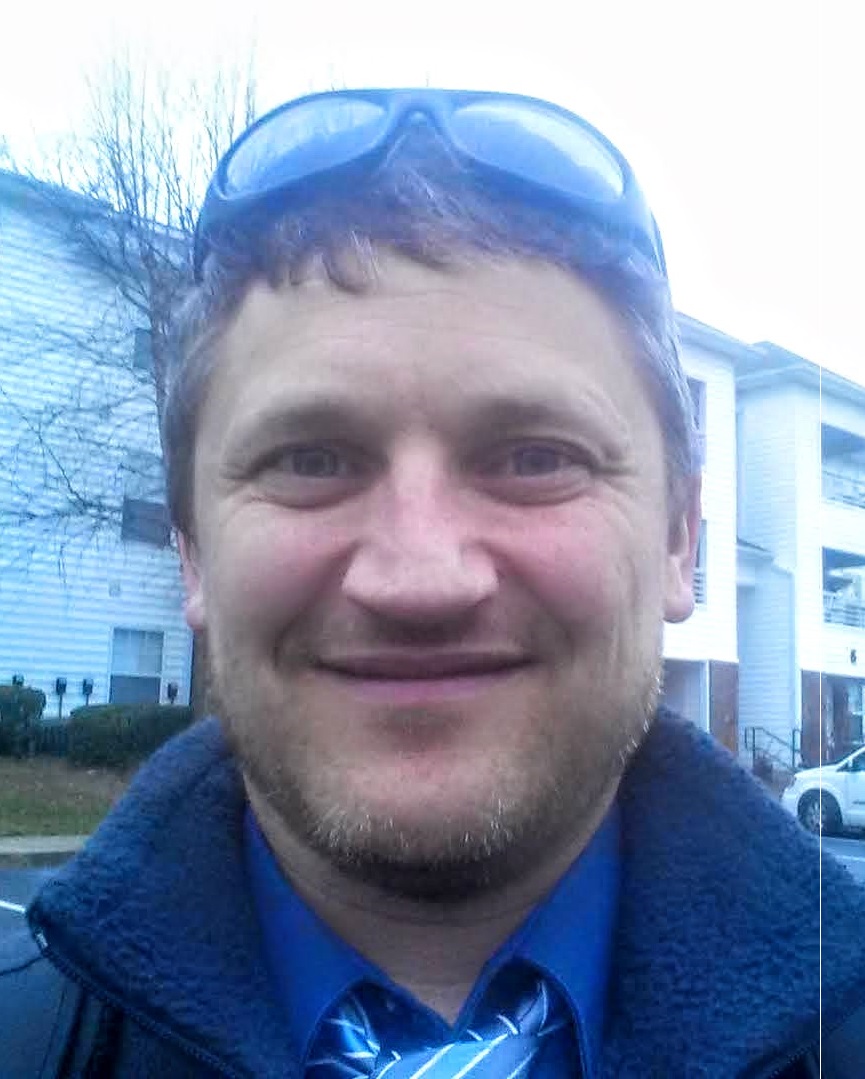 Adam Taylor teaches high school at Dickson County High School in Tennessee. Connect with Adam on Twitter @2footgiraffe, on Instagram @taylorsci, and on Tiktok @taylorsci.
Adam Taylor teaches high school at Dickson County High School in Tennessee. Connect with Adam on Twitter @2footgiraffe, on Instagram @taylorsci, and on Tiktok @taylorsci.
Note: This article was featured in the February issue of Next Gen Navigator, a monthly e-newsletter from NSTA delivering information, insights, resources, and professional learning opportunities for science educators by science educators on the Next Generation Science Standards and three-dimensional instruction. Click here to sign up to receive the Navigator every month.
Visit NSTA’s NGSS@NSTA Hub for hundreds of vetted classroom resources, professional learning opportunities, publications, ebooks and more; connect with your teacher colleagues on the NGSS listservs (members can sign up here); and join us for discussions around NGSS at an upcoming conference.
The mission of NSTA is to promote excellence and innovation in science teaching and learning for all.
Future NSTA Conferences
2019 National Conference
Follow NSTA
Teachers often aspire to help their students become more involved in a community of practice. In my classroom, members of the community are my students, as well as students in other classrooms and professional scientists. In this blog post, I will show how using science and engineering practices with technology can give students the tools and confidence they need to engage others in evidence-based discussions as part of a community of practice.
How Teachers Can Use Technology to Support 3-D Teaching and Learning
By Cindy Workosky
Posted on 2019-02-25
Three-dimensional (3-D) teaching and learning integrates the use of science practices, crosscutting concepts, and core science ideas to help students make sense of the world. From a teaching perspective, learning progressions promote the use of science practices to develop understanding of crosscutting concepts and core science ideas that can be used to explain natural phenomena. From the learning perspective, lessons engage the learner in doing science that leads to questioning; modeling; using observations and measurements to recognize patterns; developing a sense of scale; defining systems or tracing the flow of energy; and developing the capacity to understand disciplinary core ideas. Purposefully integrating technology can support 3-D learning progressions in a multitude of ways, from data collection and interactive models to lesson personalization and assessment options, thus enhancing learning outcomes for all students.
When creating rigorous 3-D learning experiences, it’s important to plan structured, face-to-face collaborations and balance them with purposefully chosen digital experiences. Having equal opportunities for digital and face-to-face experiences gives diverse student groups multiple entry points to engage with challenging content. I use a variety of technological devices: an interactive whiteboard, a document camera, cell phones, Chromebooks, iPads and probeware, and apps in conjunction with digital resources such as Schoology (a Learning Management System [LMS]), Google apps, Kahoot, PlayPosit, PhET simulations, videos, podcasts, and Poll Everywhere.
Here’s how I used technology tools to teach a segment of a curriculum from the Concord Consortium called Interactions (Unit 1, Part 1).
I began by using a smartboard to stimulate interest in a phenomenon.
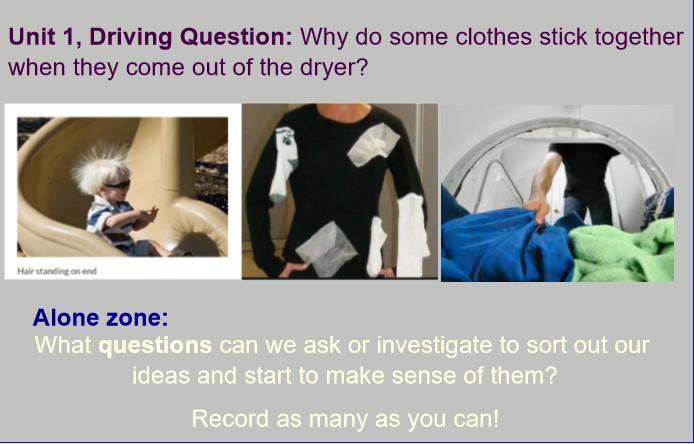 I asked students to generate questions inspired by the phenomenon, then share ideas with other students and reach consensus on their questions, facilitated by directions I provided on the smartboard. The visual clues reinforced the expectations for all students.
I asked students to generate questions inspired by the phenomenon, then share ideas with other students and reach consensus on their questions, facilitated by directions I provided on the smartboard. The visual clues reinforced the expectations for all students.

After pair, small-group, and whole-group discussions, I used the Schoology LMS to post student-generated, prioritized questions—and later, student consensus models—to a virtual driving question board that was accessible to all learners at all times. Students could contribute content and/or click on and enlarge all media input to see details at any time from any place, on any device with an internet connection.
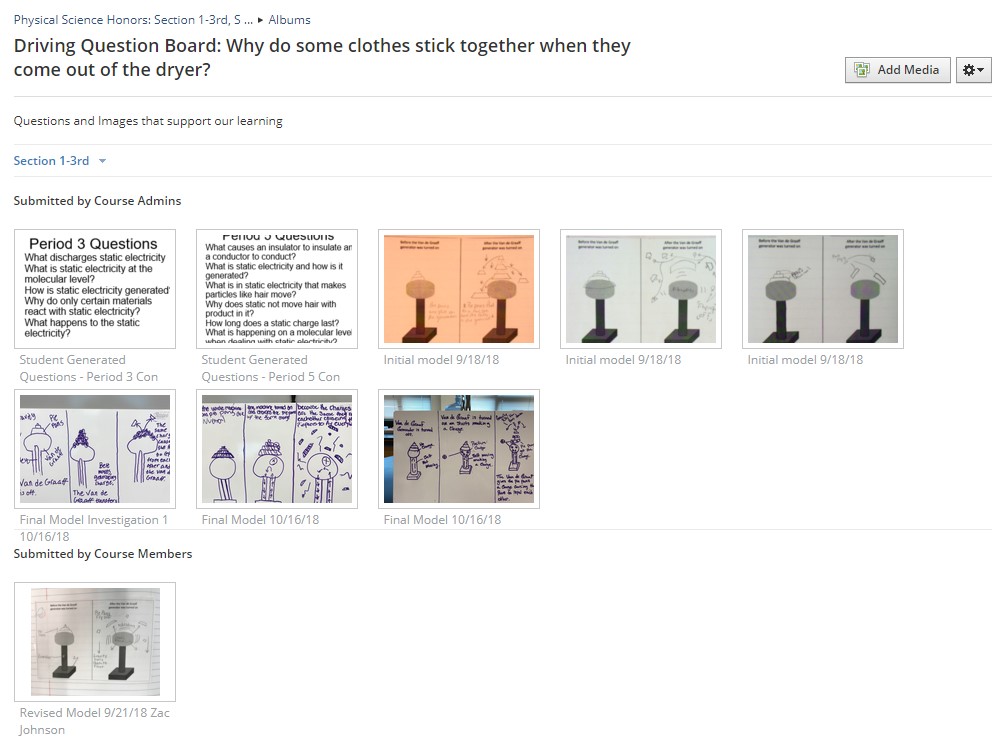
Schoology was also used to enrich learning progressions with interactive models that students used to construct understandings that lead to answers to their questions or online discussion boards. This lowered barriers and allowed all voices to be heard in response to a probing question or thought prompt.
In this learning progression, students worked independently or with a partner to build an understanding of how charged objects affect other objects without touching them.
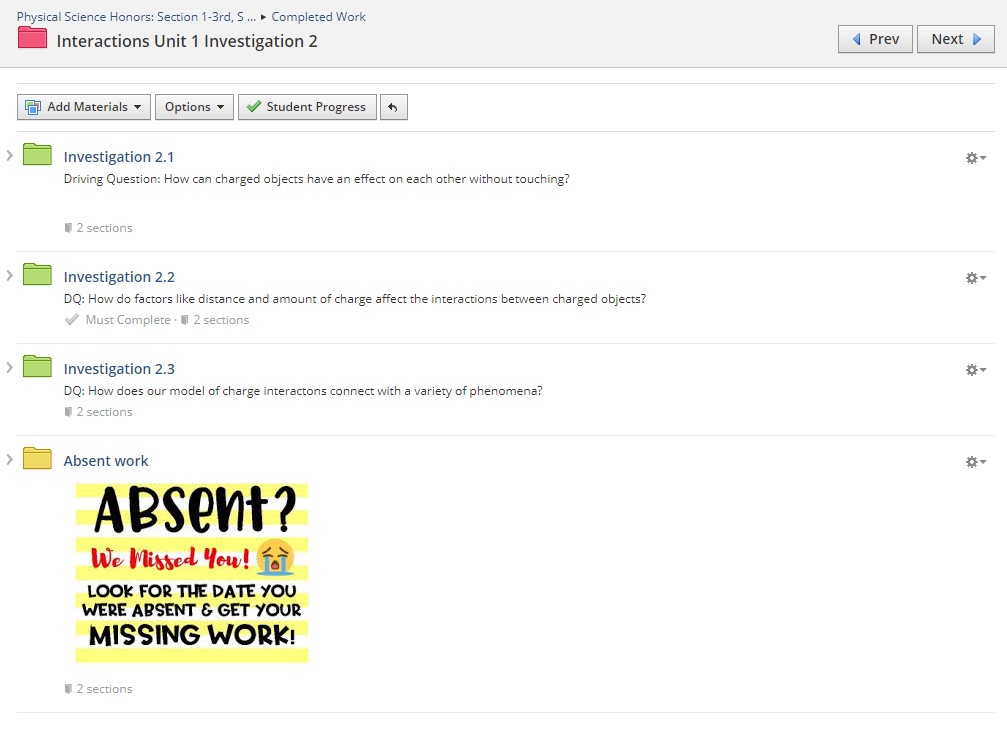
Using the LMS allowed students to have some control over the pace of their learning and enabled absent students to keep up with the class, which was key to their success. Inside the Investigation 2.2 folder, I placed a series of assignments that provided interactive simulations to initiate understanding, deepen understanding, and allow students to apply their understanding to a challenge and so they could confirm or reconstruct their ideas.
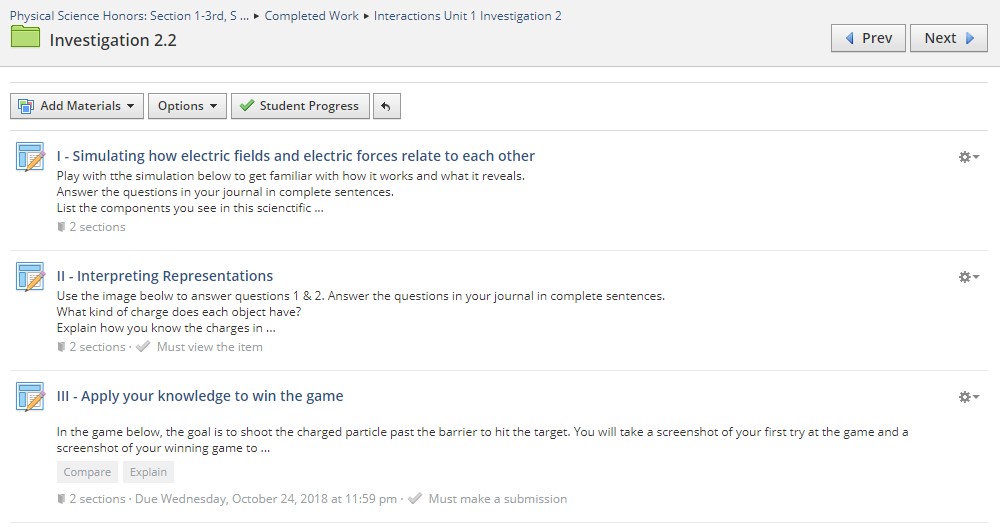
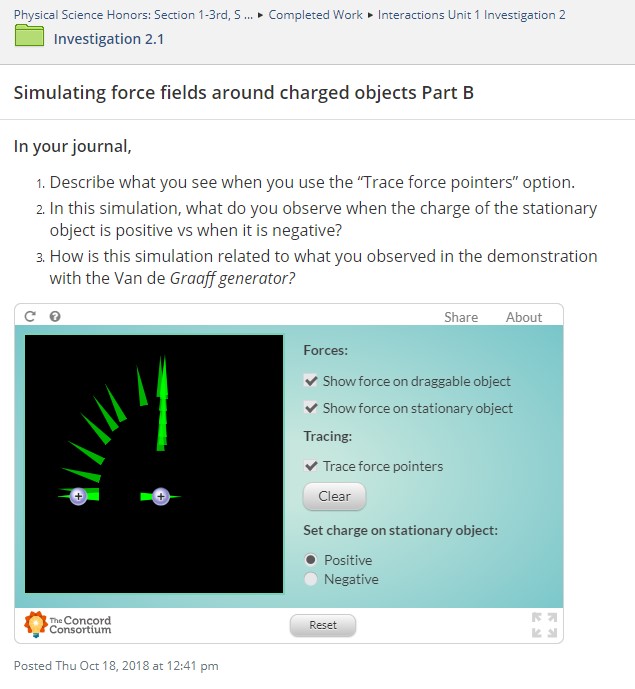
I projected shared goals, instructions, and visual prompts on the smartboard during every lesson. Individual and group consensus models were shared using the document camera linked to the smartboard, which facilitated whole-class sharing. The saved images of these models were also added to our driving question board to be used in subsequent lessons or compared to other models.
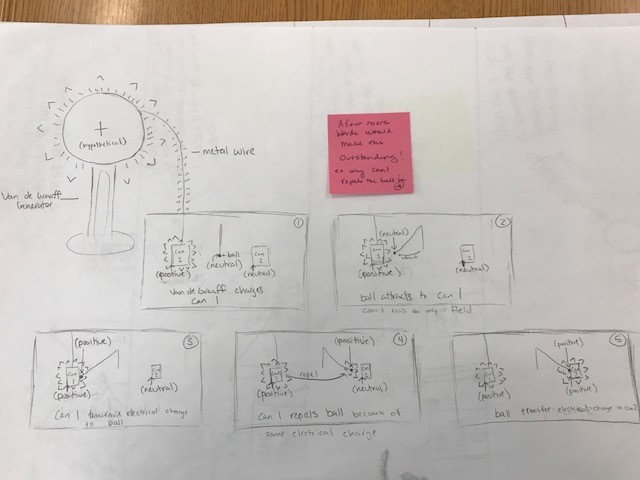
During a lesson progression, I used a student response system, Poll Everywhere, to formatively assess students. Students answered a series of questions anonymously, and the results were projected on the smartboard, stimulating productive conversation and debate that led to enhanced understanding for all students.
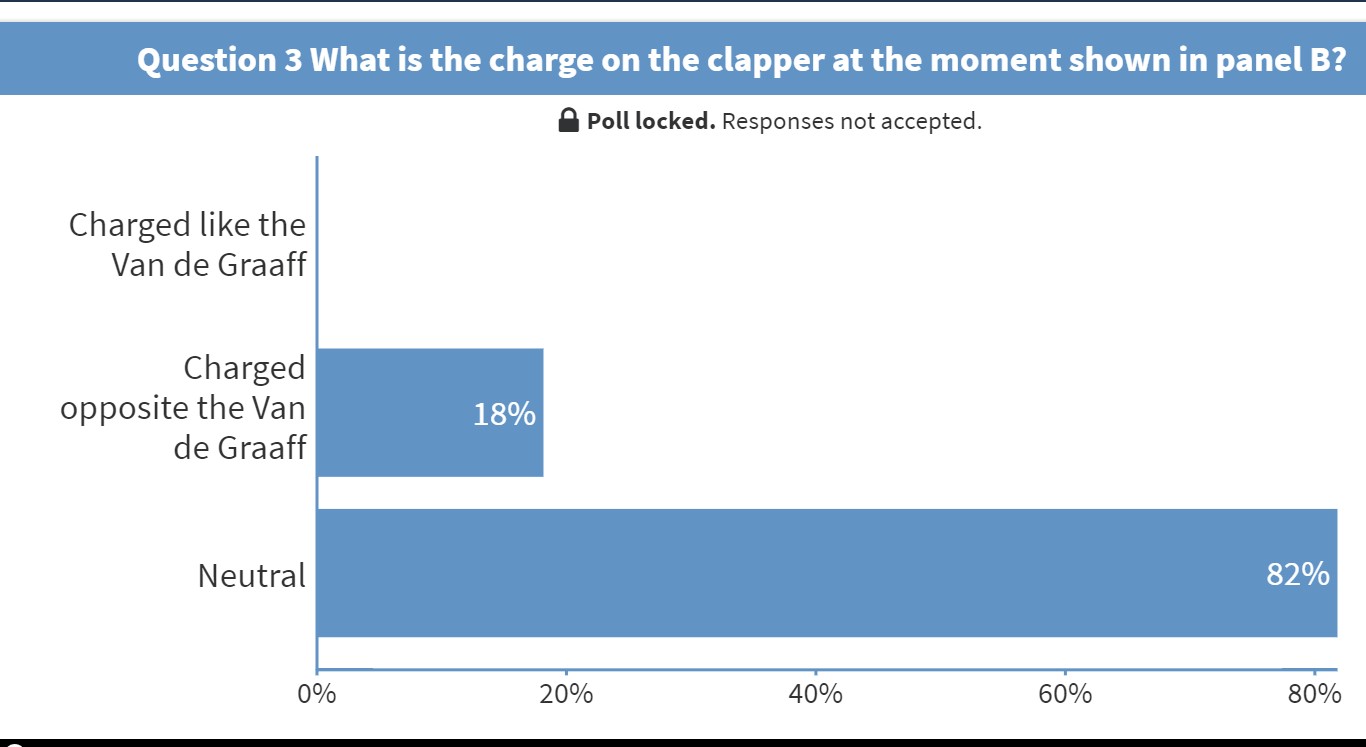
In the 21st century, students need technology to develop the cognitive and information access skills that STEM careers require. More importantly, all students deserve access to high-quality learning opportunities presented in coherent storylines, which can lead to a science-literate populace and potentially, to STEM leaders. Educational technology should be used to enrich and enhance student learning experiences, make lessons more accessible to all students, and help the teacher work more efficiently.
Exposing students to a science phenomenon and using that phenomenon to drive the learning progression provides a common experience that students, working and thinking like scientists, can use to acquire understanding of complex interactions that help them comprehend and explain their world, which is the essence of 3-D learning. Blending technology-enhanced experiences with rich and deliberate productive classroom discourse results in a safe and engaging space in which science literacy will grow in students from various cultures, socioeconomic groups, and physical and cognitive ability levels.
A major part of the NGSS vision is outlined in Appendix D: All Standards, All Students. Thus, technology can be used to level the learning environment in many ways and make rich, rigorous learning possible.
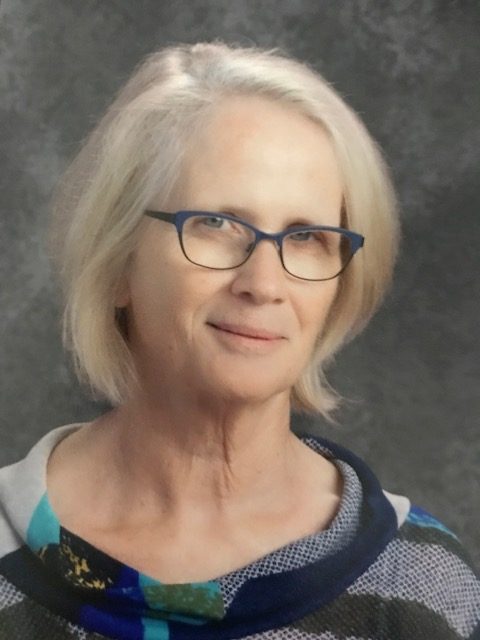 Ryan Revel teaches physical science and International Baccalaureate Biology at Sussex Central High School in the Indian River School District in Sussex County, Delaware. She is a national board–certified secondary science teacher and has taught for 10 years at the middle level and nine years at the high school level. Revel is a member of Achieve, Inc.’s Peer Review Panel and NSTA’s NGSS Facilitator Cadre. She also is a Lead Science Teacher for her school and for her school’s implementation of Schoology. Follow her on Twitter @revel56 or @RyanRevel and Instagram @rrevel.
Ryan Revel teaches physical science and International Baccalaureate Biology at Sussex Central High School in the Indian River School District in Sussex County, Delaware. She is a national board–certified secondary science teacher and has taught for 10 years at the middle level and nine years at the high school level. Revel is a member of Achieve, Inc.’s Peer Review Panel and NSTA’s NGSS Facilitator Cadre. She also is a Lead Science Teacher for her school and for her school’s implementation of Schoology. Follow her on Twitter @revel56 or @RyanRevel and Instagram @rrevel.
Note: This article was featured in the Februaryissue of Next Gen Navigator, a monthly e-newsletter from NSTA delivering information, insights, resources, and professional learning opportunities for science educators by science educators on the Next Generation Science Standards and three-dimensional instruction. Click here to sign up to receive the Navigator every month.
Visit NSTA’s NGSS@NSTA Hub for hundreds of vetted classroom resources, professional learning opportunities, publications, ebooks and more; connect with your teacher colleagues on the NGSS listservs (members can sign up here); and join us for discussions around NGSS at an upcoming conference.
The mission of NSTA is to promote excellence and innovation in science teaching and learning for all.
Future NSTA Conferences
2019 National Conference
Follow NSTA
Three-dimensional (3-D) teaching and learning integrates the use of science practices, crosscutting concepts, and core science ideas to help students make sense of the world. From a teaching perspective, learning progressions promote the use of science practices to develop understanding of crosscutting concepts and core science ideas that can be used to explain natural phenomena.
Using Collaborative Educational Technology Tools in Science
By Cindy Workosky
Posted on 2019-02-25
Science literacy is critical for our students. We need them to understand why it is important for them to do activities, such as composting. In fifth grade, one of the goals for students is to obtain information about, evaluate, and communicate how individual communities use scientific ideas to protect Earth’s resources. Using a combination of hands-on and digital learning experiences can help students achieve this goal. Helping students make the connection between the design of the compost bin and the need to protect the Earth’s resources was going to be my challenge. I knew that using tools such as hyperdocs, Google Draw, and Flipgrid, I could delve deeper into the concept of composting and really learn what my students know and understand about composting.
How was I going to ask a group of Massachusetts fifth graders to compare two designs for compost bins when we understood very little about what composting is? One of the struggles elementary educators experience in science instruction is not having a strong grasp of the material we are being asked to teach, so we are unable to demystify student misconceptions. I researched composting to create a learning experience for students that would help us all better understand the science involved in composting. We needed to understand not only why composting happened, but also how it happens. As part of this learning experience, my instruction would need to include opportunities for the students to learn about the movement of matter among plants, animals, decomposers, and the environment.
Designing this personalized learning experience led me on a journey into my pedagogical toolbox. I began compiling rich resources and collecting big questions for students to ponder. I created a hyperdoc on composting that allowed students to discover, learn, explore, design, share, and reflect. Using the hyperdoc model in the science classroom enabled students to think deeply and access multiple ways of discovery, participating in both technology-laden and non-tech activities to create strong connections to disciplinary core ideas in science. It also helped me organize my own scientific process for mastering the art of explaining composting to students.
We started the unit by exploring students’ prior knowledge of composting, asking what they knew to build on their schema. Most students had seen composting in Whole Foods stores and related it to a form of recycling. We visited our community garden compost bin, discussing practical uses for it to help our school. We observed the bin’s design and its contents. This led to the big question, “Does this compost bin suit our school’s needs, or is there a better way to build a compost bin for our school?” Students knew their task was to compare different ways of composting, then engineer “a new and improved model.” They watched a video created by a kindergarten class, as phenomena to see how someone else solved this problem. This got us started. Students were asked to explain in the hyperdoc what they learned, and now understood, about composting, as well as what questions they had.
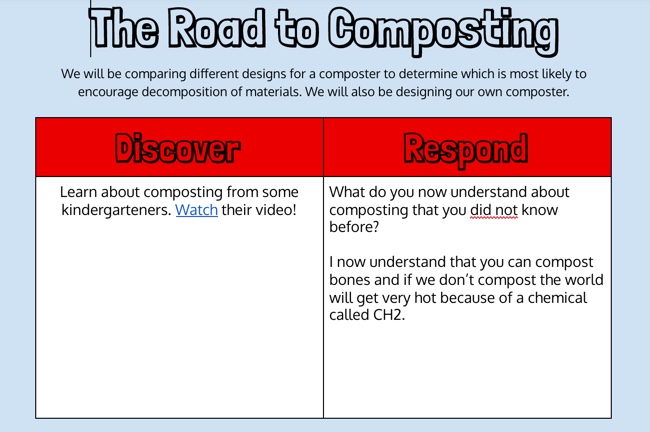
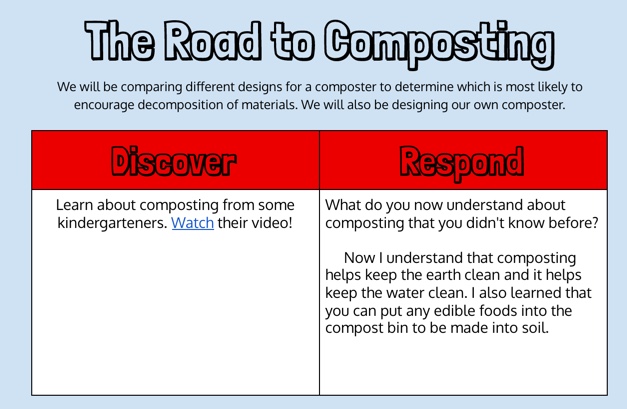
We explored composting and learned about biodegradable materials. We discovered that we eat a lot of dirt for lunch. Students made connections between what they ate and what can be composted by interviewing classmates and collecting data for a table. They were introduced to the notion of temperature change in a compost pile and played a compost card game with classmates.
During our study of ecosystems, students learned that matter moves among plants, animals, decomposers, and the environment. They needed to know that composting meant the food waste from the cafeteria was decomposing, and that they were recycling matter right in our own garden. These activities helped students develop a strong foundation in their understanding of composting, which prepared them for the task of comparing composters and creating their own compost bin. Directions were provided in the hyperdoc, and students worked at their own pace. The hyperdoc provided a way for students to learn independently and collaboratively! It also allowed me to provide learning experiences using digital and paper activities that allowed students to explore the science content more deeply.
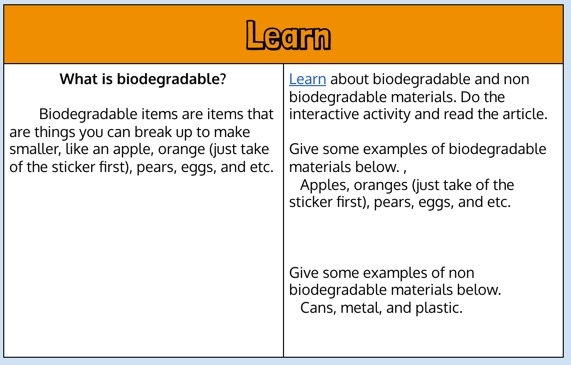
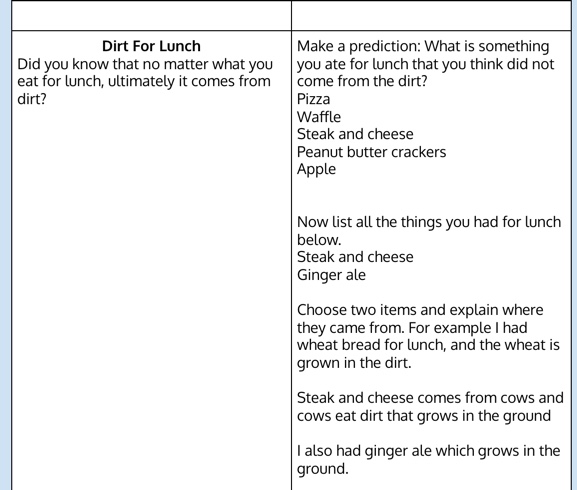
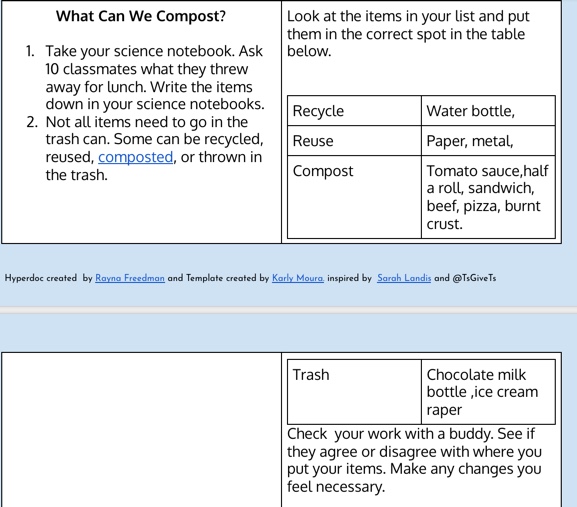
Students were asked to observe our school’s compost bin, located near our community garden. They watched a video explaining how to assemble a compost bin, and compared the knowledge they gleaned from the video with their observations of our school’s compost bin. Students then visited the Home Depot website, a task that could not be completed without technology, and chose two compost bins they were interested in purchasing for a comparison study.
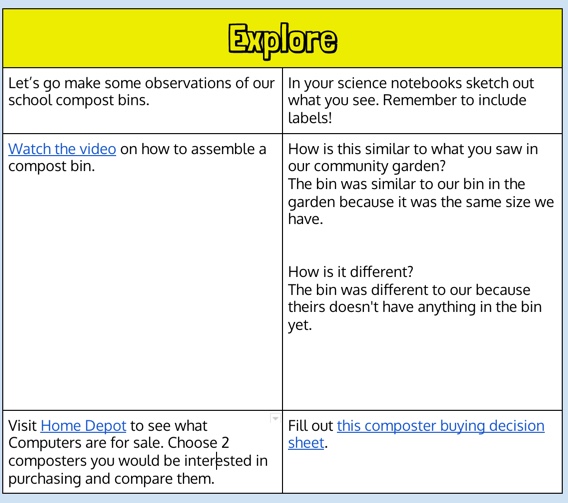
Next, students used the engineering design process to create a model of a compost bin. Engaging in this design activity provided the students the opportunity they needed to develop a model that would illustrate the movement of matter that happens throughout the composting process. They had to design improvements to the compost bin they had chosen to purchase in the previous activity. First, they had to identify changes to the compost bin and provide evidence for their rationale.
 Students then had to create a new Google Drawing for their compost model and name the compost bin. Students included labels for each part of their design. They shared their iteration with a classmate, seeking advice for what worked well and how they could improve it. They used peer feedback to make changes to the compost bin design.
Students then had to create a new Google Drawing for their compost model and name the compost bin. Students included labels for each part of their design. They shared their iteration with a classmate, seeking advice for what worked well and how they could improve it. They used peer feedback to make changes to the compost bin design.


Once drawings were completed, students shared ideas with classmates. Using Flipgrid, they created a short commercial to persuade others to purchase their compost bin. Flipgrid provided a platform for the students to engage in argument from evidence. As they were trying to persuade, they were sharing the reasoning behind their choice. Students replied to one another using academic vocabulary they learned when they were investigating movement of matter. They explained the reasoning behind whether or not they would purchase their classmate’s compost bin.
To conclude their investigation, students reflected on their experience using a Padlet. Each student was asked to create an original post, then respond to at least one other classmate. Using Padlet provided all students with another opportunity to engage in discourse about the work, ensuring that every voice spoke, including the introvert who normally would not participate in the science conversation.
In a few short weeks, students explored their ideas about composting, made observations, created and compared their compost bins, and shared their knowledge with a community of learners. The class Flipgrid and Padlet were shared with parents and on Twitter, engaging a global community in our science learning.
Using the hyperdoc was a great way to provide feedback to students as they were working, since I could observe students throughout the learning experience. I could also sit with them and explore with them, and those conversations about science were invaluable.
Using educational technology tools in the science classroom enhanced and empowered students, inspiring them to seek solutions to a problem they were previously unaware of. It is important to consider both the tool and the pedagogical reasoning for using it, as it is the students’ and teacher’s needs that must be considered first when planning activities that integrate technology. However, the learning experiences that occurred during our composting unit would not have been possible without the power of collaborative educational technology tools.
Standards Covered
MA Science Standard: 5-LS2-2(MA). Compare at least two designs for a composter to determine which is most likely to encourage decomposition of materials.*
NGSS
5-LS2-1. Develop a model to describe the movement of matter among plants, animals, decomposers, and the environment. [Clarification Statement: Emphasis is on the idea that matter that is not food (air, water, decomposed materials in soil) is changed by plants into matter that is food. Examples of systems could include organisms, ecosystems, and the Earth.] [Assessment Boundary: Assessment does not include molecular explanations.]
5-ESS3-1. Obtain and combine information about ways individual communities use science ideas to protect the Earth’s resources and environment.
3-5-ETS1-1. Define a simple design problem reflecting a need or a want that includes specified criteria for success and constraints on materials, time, or cost. 3-5-ETS1-2. Generate and compare multiple possible solutions to a problem based on how well each is likely to meet the criteria and constraints of the problem.
Common Core
RI.5.7 Draw on information from multiple print or digital sources, demonstrating the ability to locate an answer to a question quickly or to solve a problem efficiently.
RI.5.9 Integrate information from several texts on the same topic in order to write or speak about the subject knowledgeably.
W.5.1 Write opinion pieces on topics or texts, supporting a point of view with reasons and information.
W.5.8 Recall relevant information from experiences or gather relevant information from print and digital sources; summarize or paraphrase information in notes and finished work, and provide a list of sources.
W.5.9 Draw evidence from literary or informational texts to support analysis, reflection, and research.
CCSS.ELA-LITERACY.SL.5.1.A
Come to discussions prepared, having read or studied required material; explicitly draw on that preparation and other information known about the topic to explore ideas under discussion.
CCSS.ELA-LITERACY.SL.5.1.C
Pose and respond to specific questions by making comments that contribute to the discussion and elaborate on the remarks of others.
CCSS.ELA-LITERACY.SL.5.4
Report on a topic or text or present an opinion, sequencing ideas logically and using appropriate facts and relevant, descriptive details to support main ideas or themes; speak clearly at an understandable pace.
SL.5.5 Include multimedia components (e.g., graphics, sound) and visual displays in presentations when appropriate to enhance the development of main ideas or themes.
CCSS.ELA-LITERACY.SL.5.6
Adapt speech to a variety of contexts and tasks, using formal English when appropriate to task and situation. (See grade 5 Language standards 1 and 3 here for specific expectations.)
 Rayna Freedman is a fifth-grade teacher at Jordan/Jackson Elementary School in Mansfield, Massachusetts. She has taught grades 3–5 and is an Instructional Technology Specialist. She is working on earning a doctorate from Northeastern University, as she hopes to change the field of education someday. Freedman is president of Massachusetts Computer Using Educators and has presented sessions at MassCUE’s annual conference since 2010. She is a Google Level 2–certified educator, a BrainPOP–certified educator, a Flipgrid Ambassador, and a Fablevision Ambassador and serves on the Massachusetts Department of Elementary and Secondary Education Digital Literacy and Computer Science Standards Panel. Freedman has presented sessions at International Society for Educational Technology, Ed Tech Teacher Summits, Tech & Learning Leadership Summits, Medfield’s Digital Learning Day, Future Education Technology Conference, Blended & Personalized Learning Conferences, and Alan November’s Building Learning Communities Conference.
Rayna Freedman is a fifth-grade teacher at Jordan/Jackson Elementary School in Mansfield, Massachusetts. She has taught grades 3–5 and is an Instructional Technology Specialist. She is working on earning a doctorate from Northeastern University, as she hopes to change the field of education someday. Freedman is president of Massachusetts Computer Using Educators and has presented sessions at MassCUE’s annual conference since 2010. She is a Google Level 2–certified educator, a BrainPOP–certified educator, a Flipgrid Ambassador, and a Fablevision Ambassador and serves on the Massachusetts Department of Elementary and Secondary Education Digital Literacy and Computer Science Standards Panel. Freedman has presented sessions at International Society for Educational Technology, Ed Tech Teacher Summits, Tech & Learning Leadership Summits, Medfield’s Digital Learning Day, Future Education Technology Conference, Blended & Personalized Learning Conferences, and Alan November’s Building Learning Communities Conference.
Note: This article was featured in the February issue of Next Gen Navigator, a monthly e-newsletter from NSTA delivering information, insights, resources, and professional learning opportunities for science educators by science educators on the Next Generation Science Standards and three-dimensional instruction. Click here to sign up to receive the Navigator every month.
Visit NSTA’s NGSS@NSTA Hub for hundreds of vetted classroom resources, professional learning opportunities, publications, ebooks and more; connect with your teacher colleagues on the NGSS listservs (members can sign up here); and join us for discussions around NGSS at an upcoming conference.
The mission of NSTA is to promote excellence and innovation in science teaching and learning for all.
Future NSTA Conferences
2019 National Conference
Follow NSTA
Science literacy is critical for our students. We need them to understand why it is important for them to do activities, such as composting. In fifth grade, one of the goals for students is to obtain information about, evaluate, and communicate how individual communities use scientific ideas to protect Earth’s resources. Using a combination of hands-on and digital learning experiences can help students achieve this goal. Helping students make the connection between the design of the compost bin and the need to protect the Earth’s resources was going to be my challenge.
What's My Motivation?
By Gabe Kraljevic
Posted on 2019-02-25
 How do I motivate students who don’t want to do anything at all?
How do I motivate students who don’t want to do anything at all?
— B., Utah
If you ever solve this, you’ll be up for a Nobel Prize!
There is no sure-fire method that will motivate every student. So, use several methods. You can engage students’ interest in the content you are teaching by having them suggest their own ideas to investigate. For instance, a student who is interested in basketball could wonder how a ball’s pressure affects how high it bounces, which would be conducive to an experiment.
Flexibility in how some assignments are completed allows students to demonstrate their strengths and their knowledge. A rapper or musician could summarize a lesson in a music video. An artist might want to create a graphic novel. Look up multiple intelligences and universal design for learning for more ideas.
Bring in some speakers who can act as role-models, particularly school alumni if possible. Ask your speaker to talk about their challenges and how they got to where they are now. Likely, education would have been the key to their success. This may have more impact than you might expect.
Good luck, and please let me know if you ever find the right answer!
Hope this helps!
 How do I motivate students who don’t want to do anything at all?
How do I motivate students who don’t want to do anything at all?
— B., Utah
If you ever solve this, you’ll be up for a Nobel Prize!


